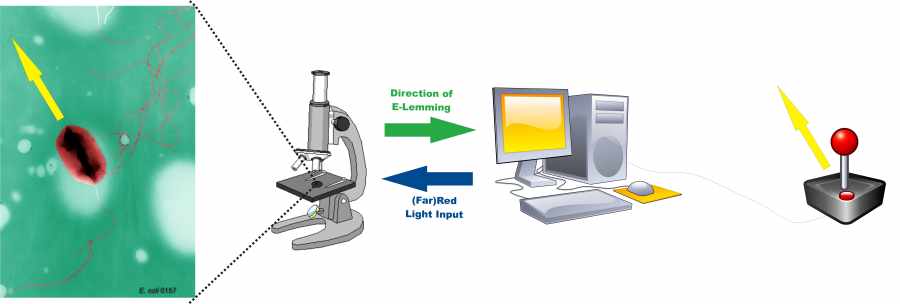Team:ETHZ Basel
From 2010.igem.org
| Line 1: | Line 1: | ||
| + | {{ETHZ_Basel10}} | ||
| + | |||
== E. lemming == | == E. lemming == | ||
[[Image:Setup.jpg|thumb|400px|'''Figure 1.''' Setup to control E. coli movements. An automatized microscope images the E. lemming. A connected computer system detects and tracks the cells. The direction of movement of the E. lemming is compared to the desired direction defined by the user, e.g. with a joystick. If the direction of movement deviates too much from the desired direction, the digital controller induces tumbling by sending a red light pulse. Otherwise, tumbling is repressed by sending a far-red light pulse.]] | [[Image:Setup.jpg|thumb|400px|'''Figure 1.''' Setup to control E. coli movements. An automatized microscope images the E. lemming. A connected computer system detects and tracks the cells. The direction of movement of the E. lemming is compared to the desired direction defined by the user, e.g. with a joystick. If the direction of movement deviates too much from the desired direction, the digital controller induces tumbling by sending a red light pulse. Otherwise, tumbling is repressed by sending a far-red light pulse.]] | ||
| Line 14: | Line 16: | ||
This years ETHZ Basel project goal is to control E.coli chemotaxis by hijacking and perturbing the tumbling / directed flagellar movement apparatus. By coupling directed flagellar movement regulating proteins to a light-sensitive spatial localization system, their activity can be controlled reversibly. A light-sensitive dimerizing complex fused to this regulating proteins and a spatial fixed location is induced by light pulses and therefore localization of the two molecules can be manipulated. Tumbling / directed flagellar movement rates are supervised by image processing algorithms, which are linked to the light-pulse generator. This system enables to control single E. coli cells to move like mindless "Lemmings" in the direction they are forced to go. | This years ETHZ Basel project goal is to control E.coli chemotaxis by hijacking and perturbing the tumbling / directed flagellar movement apparatus. By coupling directed flagellar movement regulating proteins to a light-sensitive spatial localization system, their activity can be controlled reversibly. A light-sensitive dimerizing complex fused to this regulating proteins and a spatial fixed location is induced by light pulses and therefore localization of the two molecules can be manipulated. Tumbling / directed flagellar movement rates are supervised by image processing algorithms, which are linked to the light-pulse generator. This system enables to control single E. coli cells to move like mindless "Lemmings" in the direction they are forced to go. | ||
---> | ---> | ||
| - | |||
| - | |||
| - | |||
| - | |||
| - | |||
| - | |||
| - | |||
| - | |||
| - | |||
| - | |||
| - | |||
| - | |||
| - | |||
| - | |||
| - | |||
Revision as of 19:58, 26 July 2010
E. lemming

ETHZ Basel project goal is to control E. coli movements (chemotaxis) by means of light. In fact, we will change the chemotaxis pathway either by substituting the receptor with a light-sensitive one or by interfering with the kinase-phosphatase process with proteins whose binding and unbinding can be stimulated by pulses of light. In both ways, E. coli tumbling is induced or removed just by pressing a light switch and, as a consequence, a bacterium can be "driven" to a precise, pre-fixed point. Tumbling / directed flagellar movement rates are supervised by digital controller combined with image processing algorithms. This system enables to control single E. coli cells to move like mindless "Lemmings" in the direction they are forced to go.
 "
"


